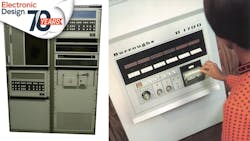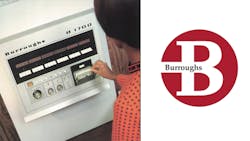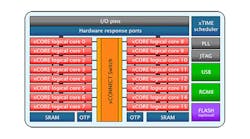What Computer Had the Biggest Impact on You?
This is part of Electronic Design's 70th Anniversary series.
We're creating image galleries from your responses to the survey below. Keep checking back as we add new galleries to the mix:
- Your First Computer - Suggestions from readers
Don't forget the survey at the end of the article or you can add comments as well below that.
Like most of you, I’ve utilized many different computers over the years. I now wear one on my wrist, use a smartphone with dozens of processor cores plus a screen that’s close to 4K, and I type this article on a PC containing a GPU with hundreds of cores that are powerful enough to do ray tracing in real-time. These are a far cry from my first computer—an HP 2000 minicomputer (Fig. 1)—that I accessed via an acoustic modem and a Teletype Model 33 with a paper tape interface (see “Do You Recognize These? Early Removable Storage”).
Since this is Electronic Design’s 70th anniversary, I thought it might be fun to find out:
- What is the first computer you used?
- What computer had the most influence on you?
- What computer did you find the most interesting?
You already know my first computer, although I did use a hydraulic logic computer before that. It was really more of a state machine rather than a programmable system, but it had AND and OR gates, and it ran off compressed air. The computer/machine was used in assembly lines.
Most Influential
The computer I think had the most influence on me was the Burroughs B1700 (Fig. 2). I got to work with one when I as a co-op student from Georgia Tech working at Burroughs Corp. It had a number of novel aspects, including bit addressing and the ability to make registers any width. It had nano- and micro-level programming that allowed the system to be optimized to support programming languages like COBOL and FORTRAN.
I was always drawn to computer architecture, but the B1700 really piqued my interest in the possibilities. I also got to work on the B6700 and B7800, which had their own architectural details. They ran programs written in Algol and Espol as well. Espol was an Algol variant featuring additional functionality that only the operating system, Burroughs Master Control Program (MCP), could use.
Most Interesting
Two computers I found fascinating were the Intel iAPX 432 and the Inmos Transputer. I didn’t get to work with either, but they had some very intriguing aspects. They also were ahead of their time, which made things a bit challenging when they came out.
The iAPX 432 had to be implemented in two chips because the company’s chip technology at the time could not accommodate the complexity. It included bit-aligned instructions, garbage collection, and object-oriented memory with capability support. The iMAX 432 operating system was written in Ada.
The Transputer was designed to be a modular system with multiple cores connected via links. There was even a switch designed to connect up to 32 transputers. The supercomputer systems like those from NVIDIA and multichip server solutions from Intel and AMD have a similar connectivity architecture. However, those systems’ connectivity is on a much grander scale, made possible by lots of transistors and high-speed serial links that were only a dream when the Transputer came out.
While I didn’t play with a Transputer, I’ve used an offspring or two from XMOS. The xCore-200 has 16 cores and an xConnect switch (Fig. 3). The xCore cores have the same communication link style as the Transputer, enabling soft peripherals to be built because of the way links and I/O-port wait operations work. I’m not doing it justice here, but it takes a bit of exploration and analysis to see how things operate. XMOS is still coming up with impressive innovations—the company developed a symmetric multiprocessing version of AWS’s FreeRTOS.
So, if you’re interested, you can provide your answers to the questions I’ve posed using the following survey, or add a comment to this article in the Voice Your Opinion! section below. Either way, I’ll collect together the more interesting comments for a follow-on article that will be linked to this one.
About the Author
William G. Wong
Senior Content Director - Electronic Design and Microwaves & RF
I am Editor of Electronic Design focusing on embedded, software, and systems. As Senior Content Director, I also manage Microwaves & RF and I work with a great team of editors to provide engineers, programmers, developers and technical managers with interesting and useful articles and videos on a regular basis. Check out our free newsletters to see the latest content.
You can send press releases for new products for possible coverage on the website. I am also interested in receiving contributed articles for publishing on our website. Use our template and send to me along with a signed release form.
Check out my blog, AltEmbedded on Electronic Design, as well as his latest articles on this site that are listed below.
You can visit my social media via these links:
- AltEmbedded on Electronic Design
- Bill Wong on Facebook
- @AltEmbedded on Twitter
- Bill Wong on LinkedIn
I earned a Bachelor of Electrical Engineering at the Georgia Institute of Technology and a Masters in Computer Science from Rutgers University. I still do a bit of programming using everything from C and C++ to Rust and Ada/SPARK. I do a bit of PHP programming for Drupal websites. I have posted a few Drupal modules.
I still get a hand on software and electronic hardware. Some of this can be found on our Kit Close-Up video series. You can also see me on many of our TechXchange Talk videos. I am interested in a range of projects from robotics to artificial intelligence.




